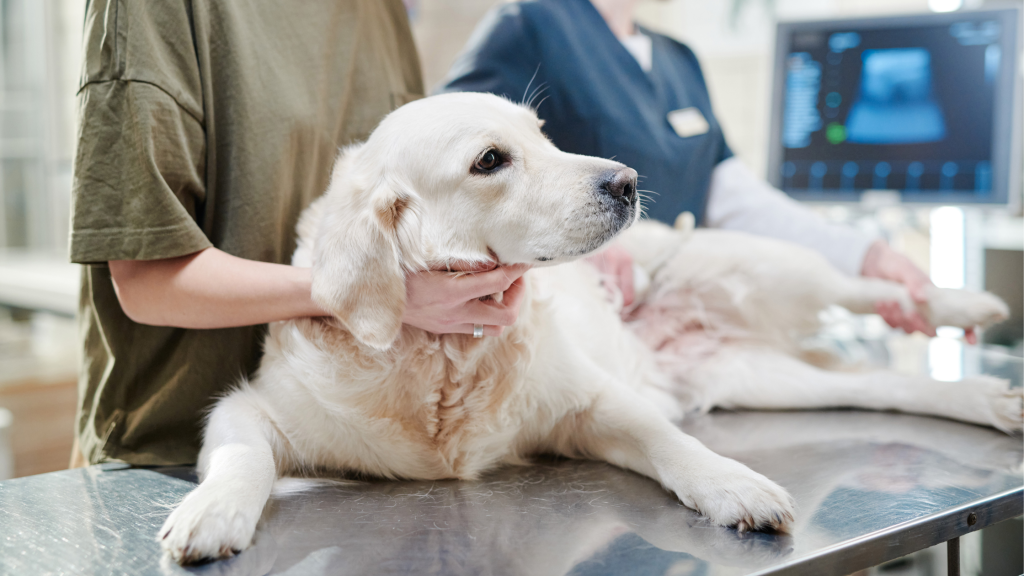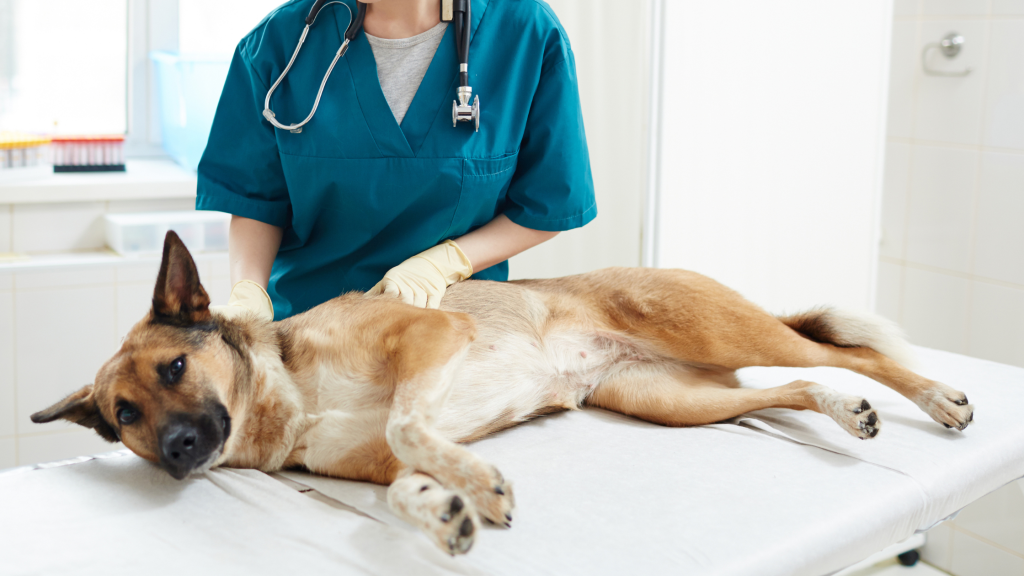Dog eye diseases can arise for various reasons and manifest themselves in different symptoms, such as tearing, redness of the dog’s eyes, or visible eye damage.
Eye diseases in dogs are most commonly caused by inflammation, allergies, or infections. Increased tearing in dogs is the most common symptom of eye disease.
Veterinary ophthalmologists, who can prescribe special drops, perform surgery, or recommend preventive measures, can help to properly diagnose and treat eye diseases in dogs.
Table of contents
Viral eye diseases in dogs
Dog eye diseases are caused by several viruses that often affect not only the eyes but also the entire body. Here are some viruses that are associated with dog eye diseases:
- Canine adenovirus (CAV-1) – causes infectious hepatitis, but can also affect the eyes, causing inflammation of the iris (uveitis) and so-called “blue eye” (corneal edema). This causes clouding of the eye and fluid accumulation in the cornea.
- Canine distemper (CDV) – the canine distemper virus can damage various tissues, including the cornea, retina, and conjunctiva. Dogs with this virus often develop redness of the eyes, discharge, and even vision problems. The virus can cause secondary eye inflammation or even retinitis, an inflammation of the retina.
- Herpes virus (CHV-1) – this virus is more common in young puppies and causes inflammation of the mucous membrane and cornea, which can lead to eye ulcers, scarring, and loss of vision.
- Parvovirus – although more commonly associated with gastrointestinal problems, in some cases parvovirus can complicate and affect the eyes, especially when the immune system is weakened.
- Canine influenza virus (CIV) – most commonly manifests as a respiratory infection, but can sometimes cause conjunctivitis (inflammation of the conjunctiva), causing redness and discharge from the eyes.
Protection against these viruses includes regular vaccinations for dogs, which help reduce the risk of infection and prevent the development of eye diseases.

Bacterial eye diseases in dogs
- Bacterial conjunctivitis is one of the most common eye diseases caused by bacteria. It is most often caused by bacteria such as Staphylococcus, Streptococcus, or Escherichia coli. Bacterial conjunctivitis manifests itself as redness, purulent discharge, and itchy eyes.
- Bacterial keratitis is an inflammation of the cornea that often occurs due to a bacterial infection after an eye injury or corneal damage. The most commonly found bacteria are Pseudomonas aeruginosa and Staphylococcus species. Bacterial keratitis causes corneal opacity, tearing, sensitivity to light, and severe pain.
- Blepharitis is an inflammation of the eyelids that can be caused by bacteria such as Staphylococcus or Streptococcus. This inflammation can cause redness, swelling, itching, and pus-filled discharge from the eyelids. Blepharitis is often chronic and requires long-term treatment.
- Dacryocystitis is an inflammation of the tear sac that can occur if the tear ducts become blocked and create conditions favorable for bacteria to multiply. Symptoms of this condition include tearing, redness around the eyes, and pus-filled discharge. The most common causes are Staphylococcus and Streptococcus bacteria.
- Uveitis – although most often caused by immune system disorders or trauma, uveitis can also be caused by bacterial infections that reach the eye from other parts of the body, such as through the bloodstream. This inflammation can cause redness, tearing, pain, and even loss of vision.
Veterinary ophthalmologists diagnose bacterial eye diseases in dogs by performing eye examinations and often taking samples to identify the bacteria causing the infection.
Treatment usually involves antibiotic eye drops or ointments, and in more severe cases, oral antibiotics may also be prescribed.

Diagnosis of eye diseases in dogs
- Schirmer test. This test helps veterinarians diagnose excessive tearing in dogs during examinations. Specialists at the Begemoto Veterinary Clinic can measure the amount of tears produced using this test. The Schirmer test is performed by placing a special, small, tear-absorbing strip in the lower eyelid for one minute.
- Fluorescein test. This test is performed at the Begemoto Veterinary Clinic when the veterinarian-ophthalmologist suspects eye damage. During the fluorescein test, the cornea is stained with fluorescein and the integrity of the cornea is observed using a special LED lamp.
- Eye tonometry. This is a painless procedure that measures the pressure in the eye. During the examination, Begemoto veterinarians can measure the pressure in the eye and determine whether your dog’s eyes are watering due to developing glaucoma.
- Bacteriological and virological tests. If, during the examination, the veterinarian suspects a bacterial or viral eye disease in your dog, special rapid tests may be performed on blood samples, or samples from the cornea, eyelids, or secretions to foreign partner laboratories for the most accurate diagnosis and treatment plan.
Every pet owner should consult a veterinarian if tears are accompanied by greenish, yellowish, or greenish-yellow discharge, or if the dog is squinting. This may indicate eye injury or bacterial or viral eye diseases in dogs.

How are dog eye diseases treated?
Dog eye diseases can be treated in many different ways, depending on the underlying cause. The treatment of bacterial and viral eye diseases in dogs requires accurate diagnosis and veterinary care, and treatment with prescription medications.
- Bacterial infections, such as conjunctivitis or corneal ulcers, are treated with antibiotic eye drops or ointments, often containing neomycin or chloramphenicol.
- Viral diseases, such as adenovirus keratoconjunctivitis, are treated with antiviral drops, such as interferon, and artificial tears. Eye cleansers or saline solution can be used to relieve symptoms, and in more severe cases, surgical intervention may be necessary.
- If the cause of eye disease in dogs is allergies, such as pollen, irritation, your veterinarian may recommend the use of antihistamines in combination with artificial tear drops to flush the eyes.
The success of treatment depends on a quick response and proper care, so if you notice redness, swelling, or discharge in your pet’s eyes, you should immediately contact your veterinarian.
Timely treatment helps to avoid complications such as loss of vision and ensures a quick recovery for your pet.
In some cases of eye watering, treatment is not necessary if the excessive watering is due to shallow eye sockets or is normal for the breed.
For these dogs, regularly clean the tear ducts with special veterinary cleansers or special veterinary soft wipes. This type of care for dogs with watery eyes can help prevent the accumulation of dirt and secondary bacterial infections.

When should you consult a veterinarian about your dog’s eye disease or watery eyes?
The most common symptoms of eye diseases that require consultation with a veterinary ophthalmologist:
- You have noticed an unusually large amount of tears. Tearing in dogs can be caused by a blocked tear duct or excessive tear production.
- Redness, discoloration, or change in coat color under the eyes. Dog owners often notice that moisture causes the coat around the eyes to turn reddish-brown, which is especially noticeable in dogs with white coats. The change in coat color around the eyes is caused by a pigment in tears called porphyrin.
- The dog squints and has difficulty opening one or both eyes.
- Greenish, yellowish, or white discharge from the eyes.
- The dog rubs its eyes with its paws and scratches.
- The dog’s eyes have become “glassy.”

Where to seek help for dog eye diseases?
The specialists working at the Begemotas Veterinary Clinic, with their innovative and modern equipment, can quickly determine the causes of eye diseases in dogs, and the canine eye doctor – ophthalmologist – can prescribe the most appropriate treatment method.
The Begemotas Veterinary Medical Center is a veterinary clinic located in the center of Vilnius, a place where not only the health of every four-legged patient is cared for, but also the emotional well-being of the patient and their owner. Register now and give your pet a clear view of tomorrow!





